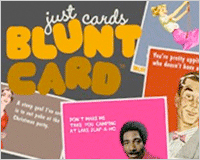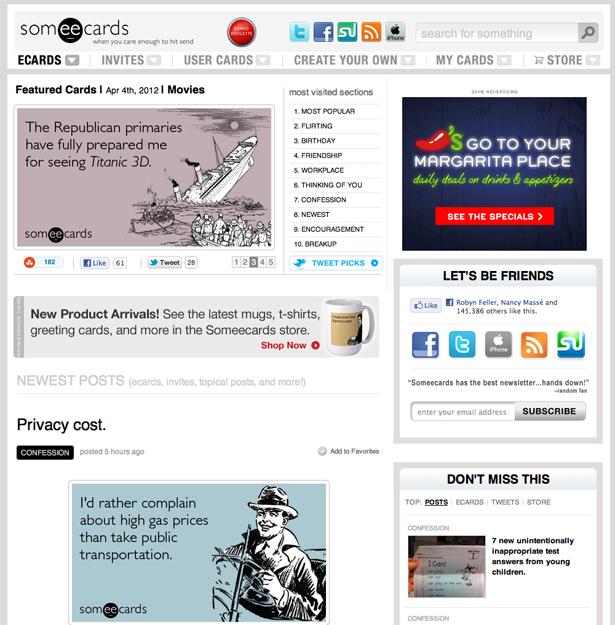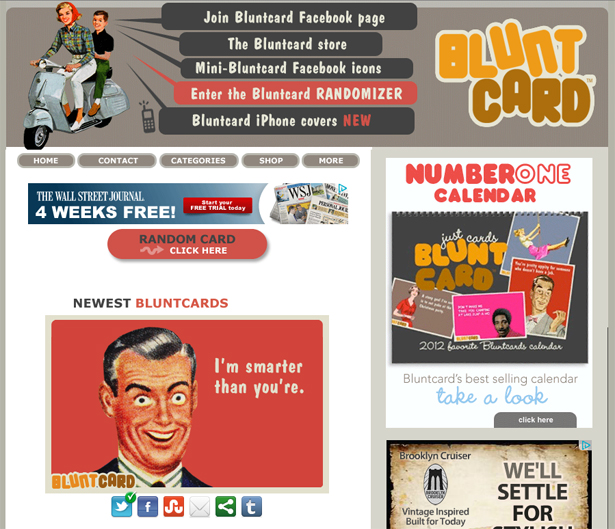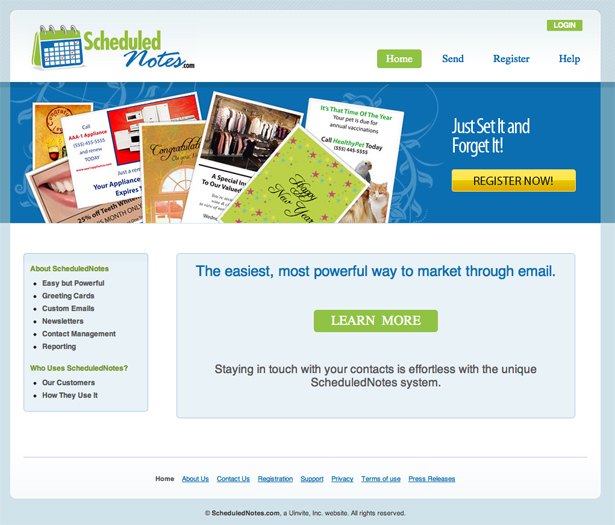 When I started working for a big greeting card company, I wanted to keep in touch with my freelance clients and contacts in the design industry.
As the usual workday was 10 hours, after work I had little energy to do mailings, make calls, or send emails to an 800 name list as those pesky little things in life like food shopping, eating, sleeping and going to the bathroom got in the way.
It’s important, especially in these weird economic times, to keep your name in front of freelance contacts because you just never know when the axe will fall upon your head at your regular-paycheck gig.
Keeping in contact with your network of contacts is important and it’s more important to do it in as efficient a manner as possible.
The company offered a nice line of interactive Flash animation ecards and the function allowed one to send one card up to 100 people at one time, inserting individual names into each card the lone addressee received. PERFECT! It took some cut and paste into my free account to get all of the names input, but after that it was easy to pick a holiday, choose a cool card and send it off within half an hour. 800 contacts received a fun little break in their day with my name attached. As people would email to tell me how much they enjoyed the card they had received, it also became apparent that they were planning on using the company service for their own needs. It was good for me and good for the company—ergo, me again!
While it seemed odd that a company that made it’s business from printed cards would put so much effort into free ecards, it showed a fun side to a 100 year-old company that was thought of as conservative and stodgy. They kept increasing the size of the ecard line until other companies caught up and free registration became a pay service.
When I started working for a big greeting card company, I wanted to keep in touch with my freelance clients and contacts in the design industry.
As the usual workday was 10 hours, after work I had little energy to do mailings, make calls, or send emails to an 800 name list as those pesky little things in life like food shopping, eating, sleeping and going to the bathroom got in the way.
It’s important, especially in these weird economic times, to keep your name in front of freelance contacts because you just never know when the axe will fall upon your head at your regular-paycheck gig.
Keeping in contact with your network of contacts is important and it’s more important to do it in as efficient a manner as possible.
The company offered a nice line of interactive Flash animation ecards and the function allowed one to send one card up to 100 people at one time, inserting individual names into each card the lone addressee received. PERFECT! It took some cut and paste into my free account to get all of the names input, but after that it was easy to pick a holiday, choose a cool card and send it off within half an hour. 800 contacts received a fun little break in their day with my name attached. As people would email to tell me how much they enjoyed the card they had received, it also became apparent that they were planning on using the company service for their own needs. It was good for me and good for the company—ergo, me again!
While it seemed odd that a company that made it’s business from printed cards would put so much effort into free ecards, it showed a fun side to a 100 year-old company that was thought of as conservative and stodgy. They kept increasing the size of the ecard line until other companies caught up and free registration became a pay service.
Ecards are all over the place
Whether a friend sends you the wonderfully weird JibJab cards or you see people post the simple but biting SomeeCards or Bluntcard on Facebook, chances are you’ve sent some sort of ecard yourself. It’s easier than one would think to create and send ecards. Certainly a simple JPEG with an interesting image and engaging copy will suffice nicely as a reminder. With the simplest Flash programming, one can make a fun, interactive card. Post a special video to YouTube and just send the link to contacts. The key is to reach out and keep in touch.
 While I suggest it’s better to use an image that promotes your own business, just putting your name in front of people is highly effective for marketing. Think about other forms of social media (sending cards are the original social media).
You’ll see that Someecards and Bluntcards contain no special programming. Any site with share functions will allow you to distribute your work. As with an article I wrote on viral images, with people sharing your ecard all over Facebook and Pinterest, you’re sure to gain notoriety!
Click HERE to create your own SomeeCard.
Click HERE to share a BluntCard.
While I suggest it’s better to use an image that promotes your own business, just putting your name in front of people is highly effective for marketing. Think about other forms of social media (sending cards are the original social media).
You’ll see that Someecards and Bluntcards contain no special programming. Any site with share functions will allow you to distribute your work. As with an article I wrote on viral images, with people sharing your ecard all over Facebook and Pinterest, you’re sure to gain notoriety!
Click HERE to create your own SomeeCard.
Click HERE to share a BluntCard.
Are paper cards dead?
Well, judging by the layoffs at Hallmark, they certainly aren’t very strong. Even Hallmark’s dipping a toe into the augmented reality pool smacks of the realization that the digital social media age is here to stay. Still, paper cards are special. People appreciate the trouble you took to pick one, write a personal message and send it via the mail. While at Hallmark, I heard many stories of people cherishing cards they received through the years. People save paper cards and will put them on bulletin boards for others to see. That’s the one failing of ecards. Another factor is, or at least was, according to the Greeting Card Association, that while only 28% of all emails are opened, 98% of greeting cards sent through the mail are opened (the 2% unopened are obviously advertisements). It’s easy to share a card on Facebook but what happens when someone receives an email with the subject line, “Speider sent you and ecard.” The first thought is, “Nigerian bank scam!” The truth is, I don’t run those scams anymore. A mix of paper and digital is the new print-on-demand companies that allow you to upload images and add your own sentiments and then they print and mail one or one million cards for you. Even the post office has gotten into the act with print-on-demand cards. Even though costs are lower than a Hallmark card or having to print 250, 500 or 1000 cards and mailing them yourself, nothing beats the cost of your own ecards.

 Several companies that do print-on-demand and handle your e-marketing. Make sure you check out all of your options and the company' reputation for cost, service and quality.
Several companies that do print-on-demand and handle your e-marketing. Make sure you check out all of your options and the company' reputation for cost, service and quality.
Why do people ignore e-blast marketing?
There’s certain e-blasts (mass emails from contacts and opt-in lists) I will check out but not many. I don’t even know how I got on most of the lists. The first thing I do is look at who sent it. Do I know them? Are they consistently interesting or are they e-morons? We just receive too many emails. Personally, I can spot an inheritance or European lottery scam right from the subject line. Because I register for sites using a fake name, I always know from the auto name insert when I’m getting a mass email by the subject, “Santa Clause, here’s your digest of messages from Temple Beth El Shalom.” Your subject line is the most important to get recipients to want to open your email. If your content is known for being beautiful, helpful, or entertaining, then people will want to open it. There’s a good chance they will eagerly await receiving it.Some impressive/depressing figures
According to Wikipedia, which many consider the Captain Redbeard Rum of information: Email marketing is directly marketing a commercial message to a group of people using electronic mail (email). In its broadest sense, every email sent to a potential or current customer could be considered email marketing. It usually involves using email to send ads, request business, or solicit sales or donations, and is meant to build loyalty, trust, or brand awareness. Email marketing can be done to either cold lists or current customer database. Broadly, the term is usually used to refer to: Sending email messages with the purpose of enhancing the relationship of a merchant with its current or previous customers, to encourage customer loyalty and repeat business, sending email messages with the purpose of acquiring new customers or convincing current customers to purchase something immediately. Google returns for "marketing via e blasts" search. There's plenty of information out there.
Researchers estimate that United States firms alone spent US $1.51 billion on email marketing in 2011 and will grow to $2.468 billion by 2016. This is a huge growth with huge potential for annoyance and overflowing email inboxes. I’m not going to look up how many hours each week we waste deleting e-blasts from our inboxes because we all know it’s too many hours.
Google returns for "marketing via e blasts" search. There's plenty of information out there.
Researchers estimate that United States firms alone spent US $1.51 billion on email marketing in 2011 and will grow to $2.468 billion by 2016. This is a huge growth with huge potential for annoyance and overflowing email inboxes. I’m not going to look up how many hours each week we waste deleting e-blasts from our inboxes because we all know it’s too many hours.
Legalities you MUST know!
In 2002 the European Union introduced the Directive on Privacy and Electronic Communications. Article 13 of the Directive prohibits the use of email addresses for marketing purposes. The Directive establishes the opt-in regime, where unsolicited emails may be sent only with prior agreement of the recipient. The directive has since been incorporated into the laws of member states. In the UK it is covered under the Privacy and Electronic Communications (EC Directive) Regulations 2003 and applies to all organizations that send out marketing by some form of electronic communication. The CAN-SPAM Act of 2003 authorizes a US $16,000 penalty per violation for spamming each individual recipient. Therefore, many commercial email marketers within the United States utilize a service or special software to ensure compliance with the Act. A variety of older systems exist that do not ensure compliance with the Act. To comply with the Act's regulation of commercial email, services typically require users to authenticate their return address and include a valid physical address, provide a one-click unsubscribe feature, and prohibit importing lists of purchased addresses that may not have given valid permission. In addition to satisfying legal requirements, email service providers (ESPs) began to help customers establish and manage their own email marketing campaigns. The service providers supply email templates and general best practices, as well as methods for handling subscriptions and cancellations automatically. Some ESPs will provide insight/assistance with deliverability issues for major email providers. They also provide statistics pertaining to the number of messages received and opened, and whether the recipients clicked on any links within the messages. The CAN-SPAM Act was updated with some new regulations including a no fee provision for opting out, further definition of "sender", post office or private mail boxes count as a "valid physical postal address", and definition of "person". These new provisions went into effect on July 7, 2008. An ecard I designed in 1999 for a local design studio. No one was doing e-marketing back then, so it was greatly received. About a year later, Mattel sent a cease and desist letter to the studio. As a former MAD Magazine art director, I knew that the piece was covered by the "Spoofing Law." After a carefully worded letter to Mattel, explaining that fact, the studio didn't receive any further communications from Mattel. I would still advise caution when using certain material when creating a derivative work.
An ecard I designed in 1999 for a local design studio. No one was doing e-marketing back then, so it was greatly received. About a year later, Mattel sent a cease and desist letter to the studio. As a former MAD Magazine art director, I knew that the piece was covered by the "Spoofing Law." After a carefully worded letter to Mattel, explaining that fact, the studio didn't receive any further communications from Mattel. I would still advise caution when using certain material when creating a derivative work.
With all of this in mind…
It’s easy and fun to create your own ecards. People love sending them as well as receiving them. You can, from your own site, create an opt-in list and email directly or use a service such as Constant Contact as an email method that contains opt-in/opt-out functions to comply with the CAN-SPAM Act. Sending should be limited to no more then once a month and keep your subject line recognizable, short and make it stand out so people will open your mailing. Perhaps make it a calendar for the month so people will use it as a desktop background? Also, don’t forget to add your information to the image data in Photoshop, which will identify it as yours and make it easier to track. A viral image can move across the web very quickly and end up in the strangest places. Be creative and use you imagination but a word of warning…as someone known for my “sharp” sense of humor, it has always been important to self-edit so as not to offend…unlike my purposeful writing. Show your ecards to a few diverse friends and see if they are concerned about the content. Offending a client or prospect is counterproductive to your marketing and business. Push the envelope…not that ecards have an envelope…but remember it’s all for business! Have you created an ecard for yourself? How do you distribute it? Post a link and share it with us!Speider Schneider
Speider Schneider is a former member of The Usual Gang of Idiots at MAD Magazine and has designed products for Disney/Pixar, Warner Bros., Harley-Davidson, ESPN, Mattel, DC and Marvel Comics, Cartoon Network and Nickelodeon among other notable companies. Speider is a former member of the board for the Graphic Artists Guild, co-chair of the GAG Professional Practices Committee and a former board member of the Society of Illustrators. Follow him on Twitter @speider or add him on Google+
Read Next
3 Essential Design Trends, November 2024
Touchable texture, distinct grids, and two-column designs are some of the most trending website design elements of…
20 Best New Websites, October 2024
Something we’re seeing more and more of is the ‘customizable’ site. Most often, this means a button to swap between…
Exciting New Tools for Designers, October 2024
We’ve got goodies for designers, developers, SEO-ers, content managers, and those of you who wear multiple hats. And,…
15 Best New Fonts, September 2024
Welcome to our roundup of the best new fonts we’ve found on the web in the previous four weeks. In this month’s edition…
By Simon Sterne
3 Essential Design Trends, October 2024
This article is brought to you by Constantino, a renowned company offering premium and affordable website design
You…
A Beginner’s Guide to Using BlueSky for Business Success
In today’s fast-paced digital world, businesses are always on the lookout for new ways to connect with their audience.…
By Louise North
The Importance of Title Tags: Tips and Tricks to Optimize for SEO
When it comes to on-page SEO, there’s one element that plays a pivotal role in both search engine rankings and user…
By Simon Sterne
20 Best New Websites, September 2024
We have a mixed bag for you with both minimalist and maximalist designs, and single pagers alongside much bigger, but…
Exciting New Tools for Designers, September 2024
This time around we are aiming to simplify life, with some light and fast analytics, an all-in-one productivity…
3 Essential Design Trends, September 2024
September's web design trends have a fun, fall feeling ... and we love it. See what's trending in website design this…
Crafting Personalized Experiences with AI
Picture this: You open Netflix, and it’s like the platform just knows what you’re in the mood for. Or maybe you’re…
By Simon Sterne
15 Best New Fonts, August 2024
Welcome to August’s roundup of the best fonts we’ve found over the last few weeks. 2024’s trend for flowing curves and…
By Ben Moss















